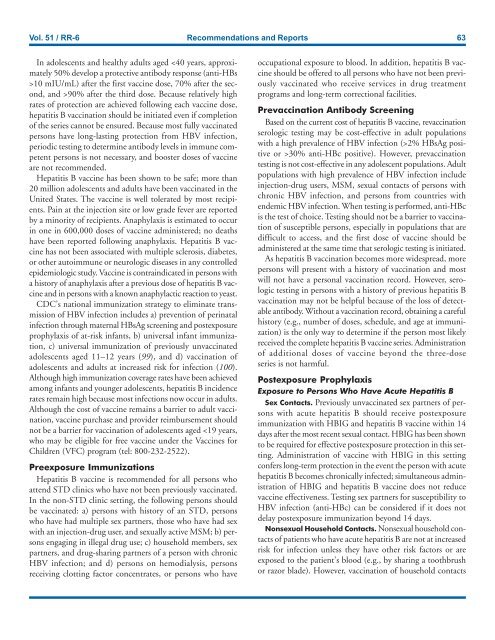Create successful ePaper yourself
Turn your PDF publications into a flip-book with our unique Google optimized e-Paper software.
Vol. 51 / RR-6 Recommendations and Reports 63<br />
In adolescents and healthy adults aged 10 mIU/mL) after the first vaccine dose, 70% after the second,<br />
and >90% after the third dose. Because relatively high<br />
rates of protection are achieved following each vaccine dose,<br />
hepatitis B vaccination should be initiated even if completion<br />
of the series cannot be ensured. Because most fully vaccinated<br />
persons have long-lasting protection from HBV infection,<br />
periodic testing to determine antibody levels in immune competent<br />
persons is not necessary, and booster doses of vaccine<br />
are not recommended.<br />
Hepatitis B vaccine has been shown to be safe; more than<br />
20 million adolescents and adults have been vaccinated in the<br />
United States. The vaccine is well tolerated by most recipients.<br />
Pain at the injection site or low grade fever are reported<br />
by a minority of recipients. Anaphylaxis is estimated to occur<br />
in one in 600,000 doses of vaccine administered; no deaths<br />
have been reported following anaphylaxis. Hepatitis B vaccine<br />
has not been associated with multiple sclerosis, diabetes,<br />
or other autoimmune or neurologic diseases in any controlled<br />
epidemiologic study. Vaccine is contraindicated in persons with<br />
a history of anaphylaxis after a previous dose of hepatitis B vaccine<br />
and in persons with a known anaphylactic reaction to yeast.<br />
CDC’s national immunization strategy to eliminate transmission<br />
of HBV infection includes a) prevention of perinatal<br />
infection through maternal HBsAg screening and postexposure<br />
prophylaxis of at-risk infants, b) universal infant immunization,<br />
c) universal immunization of previously unvaccinated<br />
adolescents aged 11–12 years (99), and d) vaccination of<br />
adolescents and adults at increased risk for infection (100).<br />
Although high immunization coverage rates have been achieved<br />
among infants and younger adolescents, hepatitis B incidence<br />
rates remain high because most infections now occur in adults.<br />
Although the cost of vaccine remains a barrier to adult vaccination,<br />
vaccine purchase and provider reimbursement should<br />
not be a barrier for vaccination of adolescents aged 2% HBsAg positive<br />
or >30% anti-HBc positive). However, prevaccination<br />
testing is not cost-effective in any adolescent populations. Adult<br />
populations with high prevalence of HBV infection include<br />
injection-drug users, MSM, sexual contacts of persons with<br />
chronic HBV infection, and persons from countries with<br />
endemic HBV infection. When testing is performed, anti-HBc<br />
is the test of choice. Testing should not be a barrier to vaccination<br />
of susceptible persons, especially in populations that are<br />
difficult to access, and the first dose of vaccine should be<br />
administered at the same time that serologic testing is initiated.<br />
As hepatitis B vaccination becomes more widespread, more<br />
persons will present with a history of vaccination and most<br />
will not have a personal vaccination record. However, serologic<br />
testing in persons with a history of previous hepatitis B<br />
vaccination may not be helpful because of the loss of detectable<br />
antibody. Without a vaccination record, obtaining a careful<br />
history (e.g., number of doses, schedule, and age at immunization)<br />
is the o<strong>nl</strong>y way to determine if the person most likely<br />
received the complete hepatitis B vaccine series. Administration<br />
of additional doses of vaccine beyond the three-dose<br />
series is not harmful.<br />
Postexposure Prophylaxis<br />
Exposure to Persons Who Have Acute Hepatitis B<br />
Sex Contacts. Previously unvaccinated sex partners of persons<br />
with acute hepatitis B should receive postexposure<br />
immunization with HBIG and hepatitis B vaccine within 14<br />
days after the most recent sexual contact. HBIG has been shown<br />
to be required for effective postexposure protection in this setting.<br />
Administration of vaccine with HBIG in this setting<br />
confers long-term protection in the event the person with acute<br />
hepatitis B becomes chronically infected; simultaneous administration<br />
of HBIG and hepatitis B vaccine does not reduce<br />
vaccine effectiveness. Testing sex partners for susceptibility to<br />
HBV infection (anti-HBc) can be considered if it does not<br />
delay postexposure immunization beyond 14 days.<br />
Nonsexual Household Contacts. Nonsexual household contacts<br />
of patients who have acute hepatitis B are not at increased<br />
risk for infection u<strong>nl</strong>ess they have other risk factors or are<br />
exposed to the patient’s blood (e.g., by sharing a toothbrush<br />
or razor blade). However, vaccination of household contacts


